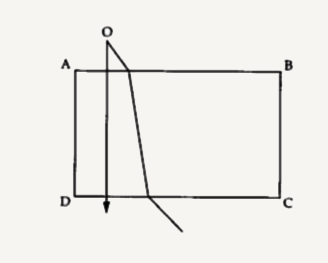The path of a ray light coming from air passing through a rectangular glass slab traced by four students are shown as A, B, C and D in Figure. Which one of them is correct ? 
A
B
C
D
The correct Answer is:B
In a rectangular glass slab, the emergent rays are parallel to the direction of the incident ray, because the lateral daviation of bending of the ray of light at the opposite parallel faces (air-glass) and (glass-air interface) of the rectangular glass slab are equal and opposite. This is why the ray emerges are parallel to the incident ray.
Topper's Solved these Questions
- LIGHT : REFLECTION AND REFRACTIONBook:NCERT EXEMPLAR ENGLISHChapter:LIGHT : REFLECTION AND REFRACTIONExercise:Short Answer Type Questions
Explore 10 Videos
- LIGHT : REFLECTION AND REFRACTIONBook:NCERT EXEMPLAR ENGLISHChapter:LIGHT : REFLECTION AND REFRACTIONExercise:Long Answer Type Questions
Explore 9 Videos
- ELECTRICITYBook:NCERT EXEMPLAR ENGLISHChapter:ELECTRICITYExercise:Short Answer Type Questions
Explore 17 Videos
- MAGNETIC EFFECTS OF ELECTRIC CURRENT Book:NCERT EXEMPLAR ENGLISHChapter:MAGNETIC EFFECTS OF ELECTRIC CURRENT Exercise:LONG ANSWER TYPE QUESTIONS
Explore 8 Videos
Similar Questions
While traching the path of a ray of light passing through a rectangular glass slab a student tabulated his observations. If in his experiment for two readings he takes two values of ∠ians40∘and50∘ . What should be the correct values of ∠eand∠r in each case ?
View SolutionA point source of light O of single colour is seen through a rectangular glass slab PQRS. The paths of two rays, in and outside the slab, are shown in figure.

In the diagram, label the position I of the source O where it will appear when seen through the surface RS.
(ii) Does the source O appear to be nearer or farther with respect to the surface PQ ?
(iii) How does the shift depend on the thickness PS or QR of the slab?
(iv) Justify your answer in (iii) with the help of an appropriate ray diagram.
(v) For the same rectangular glass slab, which colour from the visible spectra (violet to red) will produce the maximum shift ?
View SolutionLight passes through a rectangular glass slab and through a triangular glass prism. In what way does the direction of the two emergent beams differ and why?
View SolutionThe path of a ray of light passing through an equilateral glass prism ABC is shown in figure. The ray of light is incident on face BC at the critical angle for just total internal reflection. The total internal reflection. The total angle of deviation after the refraction at face AC is 108∘. Calculate the refractive index of the glass.

View SolutionA monochromatic point source of light O is seen through a rectangular glass block ABCD.
Paths of two rays, in and outside the block, are shown in the figure below.

Does the source at point O appear to be nearer or farther with respect to the surface AB?
View SolutionA ray of light falls normally on a rectangular glass slab.
Draw a ray diagram showing the path of the ray till it emerges out of the slab.
View SolutionWhen a ray of light enters a glass slab from air
View SolutionA monochromatic point source of light O is seen through a rectangular glass block ABCD.
Paths of two rays, in and outside the block, are shown in the figure below.

For the same rectangular glass block, which colour from the visible spectra will produce the maximum shift?
View SolutionA monochromatic point source of light O is seen through a rectangular glass block ABCD.
Paths of two rays, in and outside the block, are shown in the figure below.

Justify your answer with the help of an appropriate ray diagram as shown in figure.
View SolutionWhen a ray of light enters a glass slab from air.
View Solution

